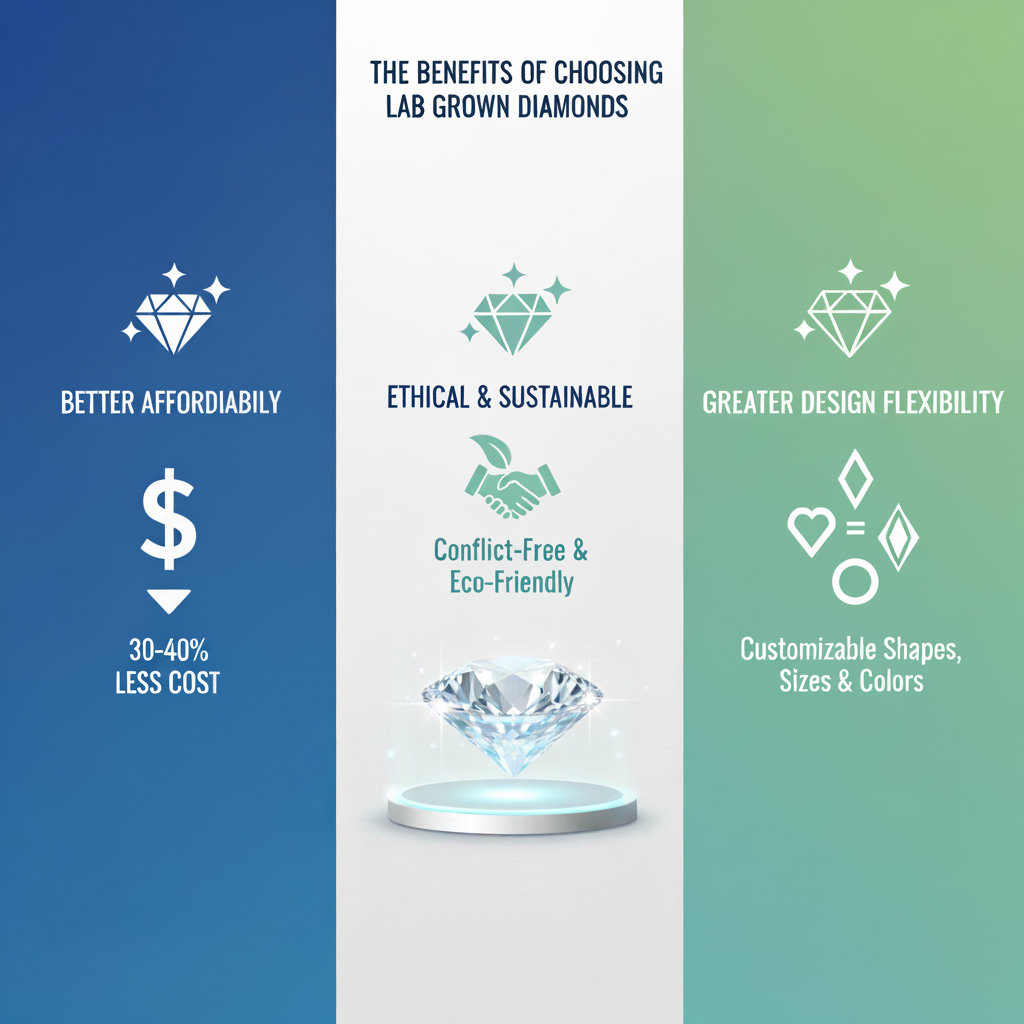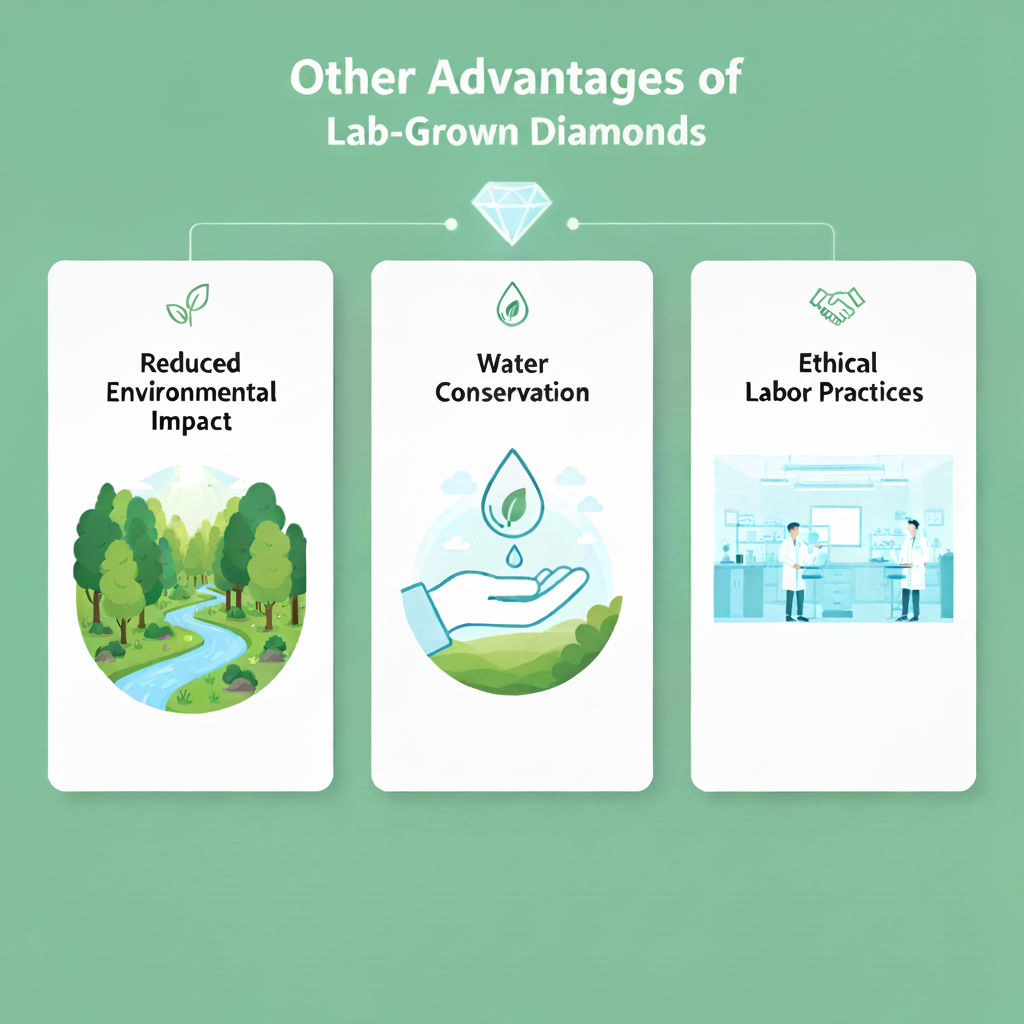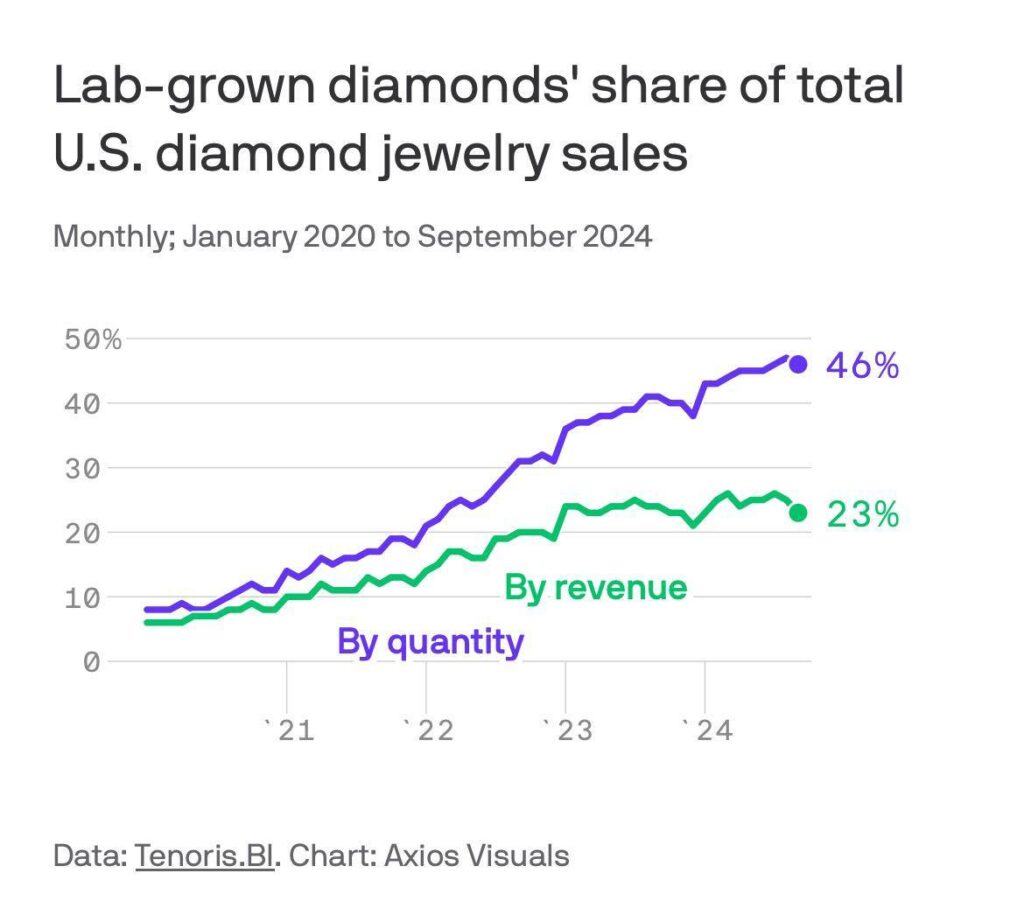Start Your Lab Grown Diamond Business Plan Today
Introduction:
Lab grown diamonds are revolutionizing the jewelry industry. They offer a sustainable and ethical alternative to mined diamonds. Lab grown diamonds have identical physical and chemical properties to natural diamonds. Therefore, they provide an exciting opportunity for entrepreneurs looking to enter the diamond business.
Discover the numerous advantages of choosing lab-grown diamonds for your next business venture. Start your Lab Grown Diamond Business Plan today! You can be part of a growing market that values innovation and environmental consciousness.
If you want to break into the diamond industry, launching a lab grown diamond business can be a lucrative opportunity. This guide will help you create a solid business plan. We will also explore market trends and help you understand the industry’s growing demand.
Understanding the Lab Grown Diamond Market
The market for lab-grown diamonds is expanding rapidly. This growth is due to the increasing demand for sustainable and ethical alternatives to mined diamonds.
Consider the accelerated market growth:
- The global lab-grown diamond market is currently valued at a robust $29.73 billion in 2025.
- It is projected to reach an estimated $34.06 billion by 2030.
- This represents a compelling Compound Annual Growth Rate (CAGR) of 8.8% during the forecast period.
Millennials and Gen Z consumers are driving this rise in demand. These buyers prioritize ethical consumption and environmental sustainability.
Why Invest in Lab Grown Diamonds?
Investing in lab-grown diamonds offers several key advantages over traditional diamond ventures:
- Sustainability: Lab-grown diamonds are eco-friendly. They eliminate the environmental damage that mining causes.
- Ethical Appeal: Unlike natural diamonds, lab-grown diamonds are conflict-free and do not involve any human rights violations. This makes them attractive to conscious consumers.
- Cost-Effectiveness: Lab-grown diamonds cost 30–40% less than mined diamonds. This allows your business to achieve higher profit margins.
- Growing Demand: Consumer preferences are shifting toward ethical and sustainable products. We expect the popularity of lab-grown diamonds to continue increasing.
Key Steps to Start a Lab Grown Diamond Business
Conduct Market Research
You must conduct thorough market research before diving into the lab-grown diamond business. This research involves several important steps:
- Understanding consumer preferences.
- Identifying key competitors.
- Assessing current market trends.
Create a Unique Selling Proposition (USP)
What will differentiate your business from its competitors? Your USP should clearly answer this question. You could focus your USP on:
- Luxury designs.
- Affordability.
- Sustainability.
- Custom-made diamond jewelry.
Find Reliable Suppliers
Partnering with reputable lab-grown diamond manufacturers is crucial. This ensures your products’ quality and consistency. Look for manufacturers that use advanced techniques. These include Chemical Vapor Deposition (CVD) or High Pressure-High Temperature (HPHT) to create high-quality diamonds.
The Benefits of Choosing Lab Grown Diamonds as a Business Venture

Lab-grown diamonds offer several benefits for entrepreneurs entering the diamond industry.
Better Affordability and Value
Firstly, lab-created diamonds are more affordable compared to earth-mined diamonds. This affordability is attractive to consumers. They get the look and quality of a diamond without the high price tag.
Secondly, lab diamonds have the same physical and chemical properties as natural diamonds. Because of this, they are indistinguishable to the naked eye. Customers, therefore, enjoy the same sparkle and brilliance at a lower cost.
Ethical and Sustainable Nature
Another advantage of lab-grown diamonds is their ethical and sustainable nature. Earth-mined diamonds are often associated with unethical mining practices and environmental damage. By contrast, scientists create lab-grown diamonds in controlled settings using minimal resources. This appeals directly to consumers who prioritize sustainability and social responsibility.
Greater Design Flexibility
Furthermore, lab-grown diamonds offer greater design flexibility. Designers can create them in various shapes, sizes, and colors. This gives jewelry designers more options when creating unique pieces. This flexibility allows entrepreneurs to cater to a wider range of customer preferences. You can also more easily tap into niche markets.
Other Advantages of Lab-Grown Diamonds:

Reduced Environmental Impact
A key ethical advantage of investing in lab-grown diamonds is their reduced environmental impact. The traditional process of mining diamonds involves:
- Extensive land excavation.
- Deforestation.
- Water pollution.
On the other hand, we create lab-grown diamonds in a controlled laboratory environment. This process uses minimal resources and energy. This significantly reduces the carbon footprint associated with diamond production.
Less Land Disruption
Traditional diamond mining excavates large areas of land to reach deep diamond deposits. This often destroys natural habitats and leads to deforestation. In contrast, lab-created diamonds require no such land disruption. They are created in laboratories using advanced technology. By choosing lab-grown diamonds, investors help preserve ecosystems and biodiversity.
Water Conservation
Mined diamond production requires substantial amounts of water. This water is needed for processes like washing ore and separating minerals. This can strain local water sources, especially in areas with existing water scarcity. However, lab diamonds do not rely on excessive water usage during their manufacturing. By opting for these diamonds, investors support responsible water conservation practices.
Ethical Labor Practices
Another significant ethical advantage is the assurance of ethical labor practices. Traditional mining has been linked to child labor, unsafe working conditions, and exploitation of miners. Lab diamonds eliminate these concerns. Scientists produce them under controlled laboratory conditions without any human rights violations.
Fair Wages and Working Conditions
The production of lab-grown diamonds involves highly skilled professionals. Scientists and technicians work in safe laboratory environments. Typically, these professionals receive fair wages and operate under regulated working conditions. By supporting man-made diamonds, investors promote ethical labor practices. They also ensure that workers involved in the diamond industry are treated fairly.
No Involvement in Conflict Diamonds
Conflict diamonds, or blood diamonds, are mined to finance armed conflicts. By investing in lab-grown diamonds, you can be certain your money is not supporting these unethical practices. Man-made diamonds have a transparent origin. They are free from any association with conflict or human rights abuses.
Cost Analysis: Initial Investment and Ongoing Costs
Launching a lab grown diamond business requires a substantial initial investment, primarily in inventory, marketing, and operational setup. Here’s a breakdown of potential costs:
| Expense | Estimated Cost |
| Lab-Grown Diamond Inventory | $50,000 – $200,000 |
| Marketing and Branding | $10,000 – $50,000 |
| E-commerce Website | $5,000 – $20,000 |
| Store Lease (if physical) | $3,000 – $10,000/month |
| Equipment and Tools | $10,000 – $30,000 |
| Legal and Regulatory Costs | $3,000 – $5,000 |
| Staffing and Training | $2,000 – $10,000 |
Ongoing Costs:
- Marketing and Advertising
- Diamond Restocking
- Employee Salaries
- E-commerce Maintenance Fees
What Sets Lab Grown Diamonds Apart from Natural Diamonds in Terms of Quality and Value
Experts often compare lab-grown diamonds to earth-mined diamonds regarding their quality and value. Both types share similar physical characteristics. However, some key differences set them apart.
1. Origin
Natural diamonds formed deep within the Earth’s mantle. This process took billions of years through intense heat and pressure. On the other hand, we create lab-grown diamonds in controlled laboratory environments. They use the High-Pressure High-Temperature (HPHT) or Chemical Vapor Deposition (CVD) methods.
2. Clarity
Lab-grown diamonds tend to have fewer internal flaws or inclusions. This is due to the controlled growth process. As a result, many lab-grown stones have higher clarity grades.
3. Color
Earth-mined diamonds come in a wide range of colors. This includes rare, fancy-colored varieties like blue or pink. Lab-grown diamonds can also exhibit various colors. However, certain hues may be more readily available because of the controlled growth process.
4. Size
We can create lab-grown diamonds in larger sizes than natural diamonds. The growth conditions in a lab allow for more control over crystal formation. This makes lab-grown diamonds an attractive option for customers. They can get larger carat weights at a more affordable price.
5. Value
Lab-grown diamonds are typically priced at a lower cost per carat than natural diamonds. This lower cost is due to the shorter production time and lower mining costs. However, the value of both diamond types can fluctuate. Market demand and other factors play a role.
Industry Data: Growth of Lab Grown Diamonds
The lab-grown diamond industry is experiencing robust and accelerating growth. According to the latest data:
- The global market for lab-grown diamonds is now valued at a strong $29.73 billion in 2025.
- The market is projected to grow at a higher CAGR of 8.8% from 2025 to 2030.
- North America and Europe remain the largest and fastest-growing markets, driving the global trend.
This surge in demand is largely driven by:
- Technological advancements.
- Cost advantages.
- Changing consumer attitudes toward sustainability.
This growth is especially evident in the consumer segment, with lab-grown stones now accounting for over 45% of all U.S. engagement ring purchases. This unprecedented market share confirms the shift in consumer sentiment toward ethical and affordable luxury.

Changing Consumer Preferences Towards Ethical Jewelry
The Rise of Ethical Consumerism
The growing interest in ethical consumerism has significantly influenced the lab-grown diamond industry. Today’s consumers are increasingly concerned about ethical practices in the supply chain. This concern includes:
- Ensuring fair labor practices.
- Avoiding conflict minerals.
- Supporting socially responsible companies.
Transparency and Traceability
Laboratory-grown diamonds give consumers a transparent and traceable alternative. Buyers can easily track their origin. This ensures they are not supporting unethical practices or human rights violations often linked to diamond mining.
Support for Local Communities
Lab-grown diamonds can have a positive impact on local communities. They can be produced in regions where traditional diamond mining has caused negative social and economic consequences. By supporting lab-grown diamonds, consumers help develop sustainable industries. These industries provide fair wages and safer working conditions for local communities.
The Process of Manufacturing Lab Grown Diamonds

Manufacturing lab-grown diamonds involves a complex and fascinating process. It harnesses the power of science and technology.
The first step is to select a tiny diamond seed. This seed serves as the foundation for the growth process. We typically place these seeds in a specially designed chamber. This chamber mimics the conditions found deep within the Earth’s mantle.
Chemical Vapor Deposition (CVD)
Chemical Vapor Deposition (CVD)
One method we use to grow lab-grown diamonds is Chemical Vapor Deposition (CVD).
The CVD Process:
- A mixture of gases containing carbon is introduced into the chamber.
- These gases are heated to extremely high temperatures. This causes them to break down and release carbon atoms.
- The carbon atoms settle on the diamond seed, layer by layer.
- Over time, this process gradually grows a larger diamond crystal.
Advantages of the CVD Method:
- Precise control over diamond growth.
- Ability to produce large and high-quality diamonds.
- Lower environmental impact compared to traditional mining.
- Reduced reliance on labor-intensive mining practices.
High Pressure-High Temperature (HPHT)
An alternative method is High Pressure-High Temperature (HPHT).
The HPHT Method:
- A small diamond seed is placed in a pressurized environment.
- The temperature reaches up to 2,500 degrees Celsius.
- Under these extreme conditions, carbon atoms bond together.
- New crystal structures form, resulting in the growth of a larger diamond.
Benefits of the HPHT Method:
- Faster production time compared to CVD.
- Ability to produce diamonds with specific colors or characteristics.
- Cost-effective for certain applications, such as industrial use.
- It allows for the creation of fancy-colored diamonds that are rare in nature.
Factors Affecting the Price of Lab Grown Diamonds
Several factors influence the price of lab-grown diamonds. These factors help make them more affordable for consumers.
Lower Production Cost
Firstly, the cost of production is lower compared to earth-mined diamonds. Scientists create lab-grown diamonds in a controlled environment using advanced technology. This process reduces the mining and labor costs associated with extracting natural diamonds. Additionally, the supply chain for lab-grown diamonds is shorter and less complex. This further contributes to their affordability.
Size and Quality (The 4Cs)
Secondly, size and quality affect the price. Just like natural diamonds, lab-grown diamonds are graded based on the 4Cs:
- Carat weight.
- Diamond color.
- Clarity.
- Cut.
Larger and higher-quality lab-grown diamonds may command a higher price. Nevertheless, they generally offer better value for money compared to their natural counterparts.
The Diamond Disruption: Strategies for Lab Grown Diamond Business Plan Success
Here are the first basic steps you need to take to start the business of lab grown diamonds online;
Building Awareness and Education
To promote a lab-grown diamond business effectively, you must build awareness and educate potential customers. They need to understand the benefits and uniqueness of these diamonds.
Key Strategies include:
- Collaborate with influencers or celebrities. They can endorse lab-grown diamonds on social media. By leveraging their following, you can reach a wider audience and generate interest.
- Host educational events or workshops. This is a powerful way to engage potential customers.
- Use word-of-mouth marketing. You can encourage customers to spread the word by rewarding them for referrals.
- Provide a virtual try-on experience. An interactive feature on your website or an augmented reality app enhances the online shopping experience and increases conversions.
Limited Market Awareness and Acceptance
A main challenge with selling lab-grown diamonds is their limited market awareness and acceptance. Many consumers are unfamiliar with lab-grown diamonds. They may also have misconceptions about their quality, value, and environmental impact.
This lack of awareness makes it challenging for retailers. They must educate and convince potential customers about the benefits of lab-grown diamonds. To overcome this, companies must invest in marketing.
Differentiating from Synthetic Gemstones
Lab-grown diamonds must clearly differentiate themselves from other synthetic gemstones. Examples of synthetic gemstones often marketed as alternatives are cubic zirconia or moissanite.
Lab-grown diamonds share a similar chemical composition and physical properties with natural diamonds. However, many consumers are not aware of these distinctions.
Sellers must educate potential buyers about the unique characteristics of lab-grown diamonds. You should highlight:
- Their identical optical properties.
- Hardness on the Mohs scale.
- Certification standards that distinguish them as genuine diamonds.
Providing clear labeling and certifications helps build trust. Customers seeking authentic lab-grown diamonds over other synthetic alternatives will appreciate this.
Competitive Pricing Pressure
The competitive pricing pressure within the diamond industry is another challenge faced by sellers of lab-grown diamonds. Earth-mined diamond producers have historically dominated the market and established pricing structures based on rarity and perceived value. Lab-grown diamonds disrupt this traditional pricing model by offering a more cost-effective alternative.
To compete effectively, sellers of lab-grown diamonds must navigate price positioning strategies that emphasize affordability without compromising quality or profitability. They need to educate customers about the significant price difference between natural and lab-grown diamonds while highlighting the shared beauty and durability aspects that make both options desirable.
The Resale Value of Lab Grown Diamonds Compared to Natural Diamonds and Factors Influencing It
Factors Affecting the Resale Value of Lab-Grown Diamonds
Lab-grown diamonds have gained popularity in recent years due to their ethical and sustainable production methods. However, when it comes to resale value, there are several factors that can influence the price a lab-grown diamond can fetch.
| Market Demand: | The demand for lab-grown diamonds plays a crucial role in determining their resale value. Currently, lab-grown diamonds constitute a smaller portion of the overall diamond market compared to earth-mined diamonds. As consumer awareness and acceptance of lab-grown diamonds increase, so does the demand for them. Higher demand generally leads to better resale value. |
| Quality and Certification: | Just like natural diamonds, the quality of a lab-grown diamond greatly impacts its resale value. Factors such as color, clarity, cut, and carat weight determine the overall quality and desirability of the stone. Additionally, having proper certification from reputable gemological laboratories adds credibility and can positively impact the resale value. |
| Brand Reputation: | The reputation of the brand or manufacturer behind the lab-grown diamond can also influence its resale value. Established brands with a track record of producing high-quality lab-grown diamonds may command higher prices in the secondary market compared to lesser-known or generic brands. |
The Resale Value Comparison: Lab-Grown vs Natural Diamonds
When comparing the resale value of lab-grown diamonds to natural diamonds, some key differences arise.
| Rarity: | Natural diamonds are formed over millions of years under intense pressure and heat deep within the Earth’s crust, making them rare and highly sought after. This inherent rarity contributes to their higher resale value compared to lab-grown diamonds, which can be produced in a matter of weeks. |
| Perceived Value: | Traditional consumers often perceive natural diamonds as having more value and desirability due to their long-standing association with luxury and romance. This perception can impact the resale value, as some buyers may be willing to pay a premium for a natural diamond over a lab-grown one. |
| Market Dynamics: | The diamond market is complex and influenced by various factors such as supply and demand, economic conditions, and industry trends. Natural diamonds have an established market with well-defined pricing mechanisms, while the lab-grown diamond market is still evolving. This difference in market dynamics can affect the resale value of each type of diamond. |
Advancements in Technology and Production Techniques
Improvements in Diamond Growing Processes
Technological advancements have significantly improved the efficiency and quality of lab-grown diamond production. Innovations such as chemical vapor deposition (CVD) and high-pressure high-temperature (HPHT) methods have made it possible to grow larger, higher-quality diamonds at a faster rate. These advancements have also led to increased color options, allowing lab-grown diamonds to be produced in various shades beyond traditional white.
Innovation in Cutting and Polishing Techniques
Alongside improvements in diamond growing processes, there have been innovations in cutting and polishing techniques specific to lab-grown diamonds. As these stones exhibit different properties from natural diamonds, specialized cutting techniques have been developed to maximize their brilliance and fire. This ensures that lab-grown diamonds can achieve the same level of beauty as their mined counterparts, further enhancing their desirability in the market.
Expanding Market Presence and Consumer Acceptance
Growing Availability and Affordability
As the lab-grown diamond industry continues to mature, there has been a significant increase in the availability and affordability of these diamonds. More companies are entering the market, offering a wider range of lab-grown diamond options to consumers. This increased competition has led to price reductions, making lab-grown diamonds more accessible to a broader customer base.
Shift in Consumer Perception
There has been a notable shift in consumer perception towards lab-grown diamonds. Initially viewed as an inferior alternative, lab-grown diamonds are now being recognized for their unique advantages and qualities. As awareness about their sustainability, ethical sourcing, and technological advancements spreads, consumers are becoming more accepting of lab-grown diamonds as a desirable choice for fine jewelry and bespoke jewelry. The growing acceptance of these diamonds is reflected in their increasing popularity among millennials and environmentally conscious buyers.
Overall, these trends and innovations are shaping the future of the lab-grown diamond industry by driving demand through sustainable and ethical considerations, advancing technology for improved production techniques, and expanding market presence while gaining consumer acceptance.
Expanding into Emerging Markets
Identifying Opportunities in Developing Economies
The lab-grown diamond business has immense potential for growth by tapping into emerging markets. These markets, primarily located in developing economies, offer a significant customer base that is increasingly becoming more aware of the benefits and ethical considerations associated with lab-grown diamonds. By identifying these opportunities, companies can strategically position themselves to capture market share in regions such as Asia, Africa, and South America.
Key Strategies:
– Conduct thorough market research to understand the preferences and purchasing power of consumers in emerging markets.
– Establish partnerships with local retailers or distributors to gain access to distribution channels.
– Customize marketing campaigns and messages to resonate with the cultural values and aspirations of customers in specific regions.
Addressing Affordability Concerns
Why Consumers Choose Affordable Lab-Grown Diamonds
One major advantage of lab-grown diamonds is their comparatively lower price point than natural diamonds. However, affordability remains a concern for many potential customers, especially in emerging markets where price sensitivity is high. To expand into these markets successfully, it is crucial to address this concern by implementing pricing strategies that make lab-grown diamonds more accessible.
Key Strategies:
– Offer flexible financing options or installment plans to make purchasing lab-grown diamonds more affordable for customers.
– Introduce entry-level product lines or smaller carat sizes at competitive prices.
– Educate consumers about the long-term value proposition of lab-grown diamonds compared to natural diamonds.
Targeting Specific Customer Segments
Capturing Millennial Consumers
Millennials are an important target demographic for the lab-grown diamond business due to their increasing influence on consumer trends and their preference for sustainable and ethically sourced products. To effectively capture this segment, companies need to understand their unique preferences and tailor their marketing efforts accordingly.
Key Strategies:
– Leverage social media platforms and digital marketing techniques to reach and engage with millennial consumers.
– Highlight the eco-friendly and conflict-free aspects of lab-grown diamonds in marketing campaigns.
– Collaborate with influencers or brand ambassadors who align with millennial values to promote lab-grown diamonds.
Meeting the Demand for Customization
Another customer segment that can be targeted in the lab-grown diamond business is those seeking personalized and customizable jewelry. By offering a wide range of design options and customization features, companies can cater to this demand and differentiate themselves from competitors.
Key Strategies:
– Develop an online platform or tool that allows customers to design their own lab-grown diamond jewelry.
– Collaborate with renowned designers or offer partnerships with jewelry customization experts.
– Provide a diverse selection of settings, metals, and gemstone combinations to suit individual preferences.
Mentorship Programs
In addition to industry associations, mentorship programs play a crucial role in supporting new businesses within the lab-grown diamond industry. These programs connect experienced professionals with aspiring entrepreneurs or startups to provide guidance, advice, and support based on their own experiences.
Mentors can share valuable insights into navigating challenges specific to the lab-grown diamond sector, such as sourcing raw materials, establishing supply chains, or marketing strategies. By leveraging the knowledge and expertise of mentors who have already succeeded in this business realm, new businesses can gain a competitive advantage and avoid common pitfalls.
Benefits of Mentorship Programs:
– Access to experienced professionals who have already achieved success in the lab-grown diamond industry
– Guidance on strategic decision-making tailored specifically for lab-grown diamonds
– Insights into best practices for sourcing raw materials ethically and sustainably
– Assistance with developing effective marketing and branding strategies
Conclusion:
Choosing lab-grown diamonds for your next business venture is a smart move due to their affordability, ethical production, and increasing popularity. Lab-grown diamonds offer high-quality, sustainable jewelry that appeals to environmentally conscious consumers. With advancements in technology and celebrity endorsements, lab-grown diamonds have gained significant traction in the market. Their comparable quality to natural diamonds, combined with lower prices and greater design flexibility, makes them an attractive option for entrepreneurs looking to tap into the diamond industry.
FAQ
Are lab-grown diamonds as durable as natural diamonds?
Yes, lab-grown diamonds have the same hardness and durability as natural diamonds.
How much does it cost to start a lab-grown diamond business?
Initial startup costs range from $100,000 to $300,000, depending on inventory, marketing, and operational expenses
Can lab-grown diamonds be certified?
es, lab-grown diamonds can be certified by reputable gemological labs such as GIA and IGI.
What is the profit margin for lab-grown diamonds?
Profit margins typically range from 20% to 40%.
Is the lab-grown diamond market growing?
Yes, the market is expected to grow at a CAGR of 7.8% between 2023 and 2030.

